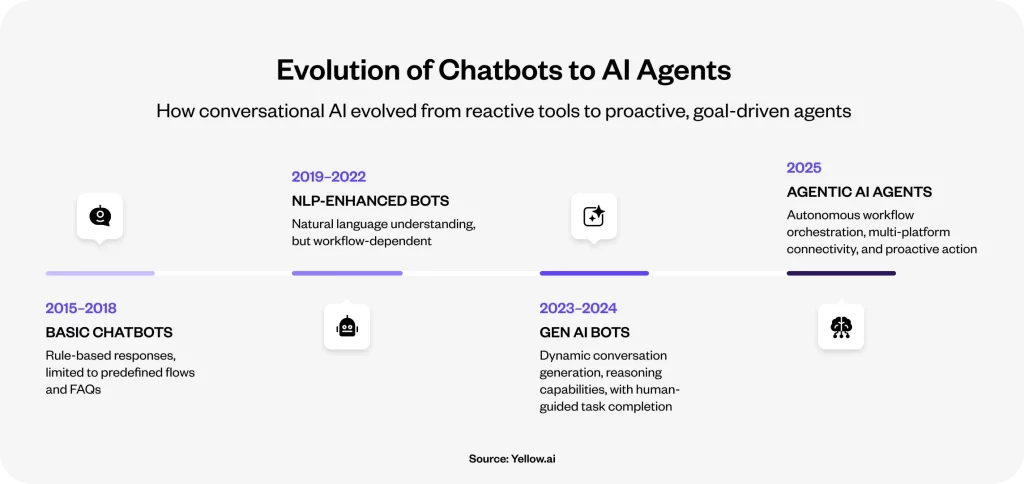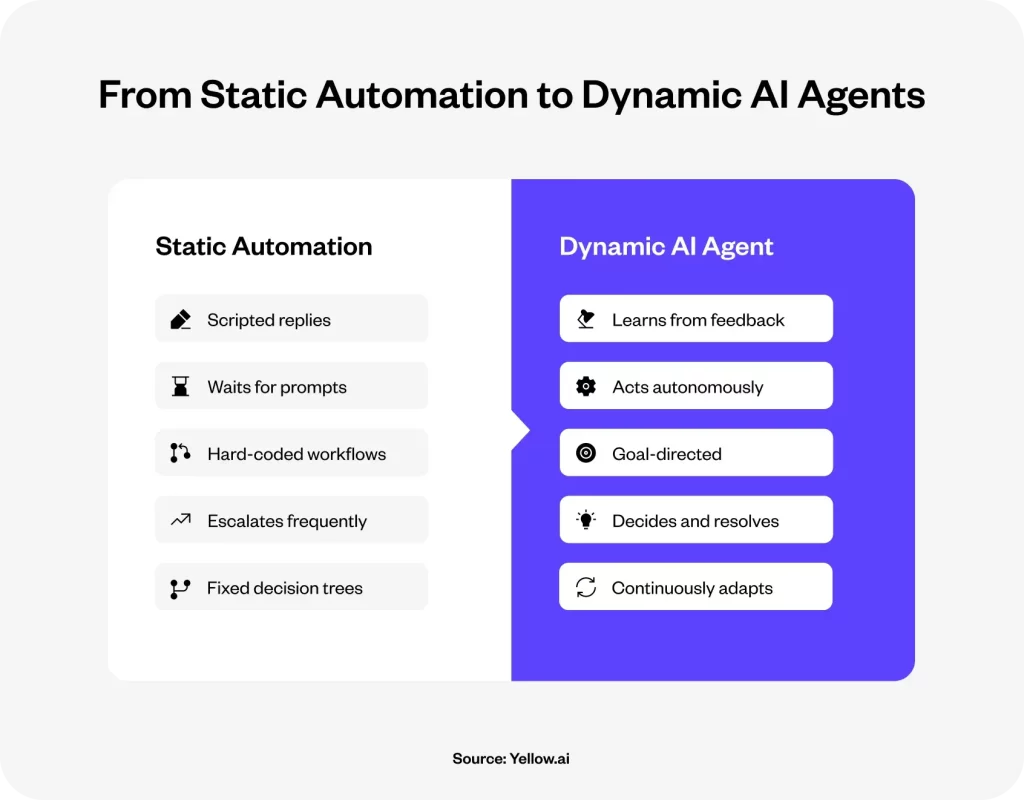According to Gartner, by 2026, over 70% of enterprise conversations will be handled by AI agents, not chatbots. In the world of customer service automation, chatbots were just a stepping stone. In 2025, enterprise leaders aren’t asking “How do we build a chatbot?”, they’re asking “How do we deploy AI agents that actually move the needle?” This blog unpacks the shift from traditional chatbots to intelligent, agentic AI, and what it means for how your business serves, sells, and scales.
From Chatbots to AI Agents – What Changed?
Chatbots once played a critical role in helping enterprises scale basic support functions and deflect repetitive queries. But as customer expectations continue to mature and operational complexity grows, traditional chatbots began to fall short. Their reliance on scripted flows, lack of contextual understanding, and inability to integrate with core enterprise systems have made them increasingly inadequate for real-time, outcome-driven customer experience.
In contrast, AI agents have emerged to meet this rising bar. These are autonomous, decision-capable systems designed to understand context, remember customer history, and execute tasks across multiple enterprise functions.
Whether supporting CX, sales enablement, or internal IT operations, AI agents represent a scalable, cross-functional solution built for modern digital ecosystems.

The Shift to AI Agents – What Changed
Generative AI brought human-like fluency to conversations, but language alone doesn’t drive outcomes. In enterprise settings, what matters is action. Agentic AI goes beyond talk, combining intelligence with orchestration to execute tasks, trigger workflows, and deliver measurable results across CX, EX, and IT operations.
1. Generative AI Set the Stage
Large Language Models (LLMs) introduced reasoning, memory, and natural language fluency. These models enabled natural, fluent, and contextually aware conversations, bringing a human-like quality to digital interactions. But as impressive as conversational fluency was, enterprises quickly realized that being able to “talk” wasn’t enough. Business value hinged on whether AI could do something useful with that conversation.
In enterprise settings, what matters most is execution. LLMs provided the foundation, but agentic AI built on top of that, embedding reasoning capabilities into workflows, learning from user behavior, and acting in real time. This paved the way for AI agents that don’t just respond, but deliver measurable impact across business functions.
Related: Building an AI Strategy That Survives Rapid Evolution of LLMs
2. Enterprises Outgrew Scripts
Static, rule-based chatbots couldn’t scale with rising CX complexity. Support leaders, ITSM heads, and EX teams needed intelligent systems that could resolve, not just respond. The early chatbot era was defined by rules and decision trees. These tools worked for simple FAQs but broke down when customer journeys became more complex, more integrated, and more personalized. Enterprises were constrained by systems that couldn’t adapt on the fly, lacked depth, and failed to keep up with expectations from both customers and internal users.
Modern CX, EX, and ITSM leaders demand more than containment. They wanted automation that could truly resolve issues, integrate with back-end systems, adapt to changing inputs, and operate across channels. That meant moving from reactive support flows to proactive, intelligent agents capable of enterprise-grade orchestration.
3. Agentic AI = Execution + Orchestration
Unlike traditional chatbots that merely route or answer queries, AI agents are built to act. They trigger workflows based on real-time inputs, retrieve and update customer data from multiple systems, and escalate conversations when human intervention is necessary. Their value lies in their autonomy, able to reason, decide, and execute across enterprise layers.
These agents don’t rely on pre-built flows alone. They blend conversational interfaces with business logic and process automation to drive outcomes. Whether resolving a service ticket, qualifying a lead, or escalating a compliance issue, AI agents are now functioning as intelligent digital teammates within enterprise ecosystems.
Key Takeaway: AI agents are not chatbot upgrades. They’re built for enterprise complexity and scale.
Chat vs. AI Agents: What Enterprises Must Understand
While chatbots were built to answer questions, AI agents are built to get things done. The difference isn’t just technical, it’s foundational to how enterprises automate, personalize, and scale operations in a complex, multi-channel environment.
Understanding this shift is crucial for enterprise leaders making CX, EX, or ITSM investments. AI agents combine context, memory, and decision-making to go beyond conversation, turning every interaction into a measurable business outcome.
For enterprise leaders evaluating automation investments, here’s a clear view of how traditional bots stack up against today’s AI agents.
| Criteria | Traditional Chatbots | AI Agents |
| Approach | Scripted, rule-based | Autonomous, adaptive |
| Context Awareness | Minimal | High (retains mulit-turn context across sessions) |
| Channel Support | Limited (mostly web chat) | Omnichannel (web, app, WhatsApp, voice, email and many more) |
| Backend Integration | Basic or none | Seamless API integration (CRM, ERP, ITSM) |
| Proactivity | Reactive (responds to queries) | Proactive (triggers workflows, reminders) |
| Scalability | Fixed logic paths | Self-improving, scalable with data and usage |
| Use Cases | FAQ, ticket deflection, basic routing | CX, EX, ITSM, Sales & Ops enablement |
Frequently asked questions (FAQs) about chatbots and AI agents
Are chatbots becoming obsolete in 2025?
Yes. Traditional chatbots are being replaced by AI agents powered by Generative AI. These agents offer context awareness, real-time decision-making, and backend integrations that chatbots can’t match.
What is the difference between a chatbot and an AI agent?
Chatbots follow scripts. AI agents, built on large language models (LLMs), adapt dynamically, understand context, and execute tasks across systems—making them smarter and more scalable.
How does Generative AI enhance AI agents?
Generative AI gives AI agents the ability to understand language deeply, generate human-like replies, and make smart decisions in real time. This results in natural, fluid conversations.
How do AI agents improve CX compared to chatbots?
AI agents reduce friction, personalize responses, and handle complex, multi-step queries across channels. This leads to faster resolutions and higher customer satisfaction.
What industries are leading in adopting AI agents?
Banking, retail, telecom, healthcare, and travel industries are leading AI agent adoption due to their need for scalable, intelligent customer engagement.
What makes AI agents enterprise-grade?
Enterprise-grade agents include governance, orchestration, LLM-powered intelligence, scalability, and deep system integration—enabling them to handle critical business tasks reliably.
Chat Is Just a Channel – The Service Ecosystem Has Changed
1. Context-Aware Conversations Across the Lifecycle
AI agents now manage full-funnel engagement with context and memory, unlike traditional bots that start from scratch every time. From initial qualification to ongoing service, they retain user data, interpret intent, and adapt messaging based on evolving customer journeys. This enables highly relevant interactions at every stage, resulting in more efficient resolutions and better user experience.
2. Multimodal Orchestration: Voice, App, Chat, Email
Modern customers engage across multiple channels, and expect seamless continuity. AI agents break down channel silos by orchestrating workflows across voice, app, chat, and email as a unified experience. Whether a customer starts a query via WhatsApp or transitions to voice, the agent keeps context intact and ensures consistency.
3. Personalization and Real-Time Action
AI agents integrate directly with CRMs, ERPs, and ticketing systems to deliver dynamic, personalized responses and trigger backend actions in real-time. Whether it’s updating a customer profile, escalating a ticket, or initiating a follow-up, every interaction is designed to move the conversation toward resolution and impact.
Real Enterprise Use Cases for AI Agents
BFSI
In the banking and financial services sector, AI agents are being deployed to provide seamless, secure, and highly efficient customer service. They handle high-volume interactions like KYC verification, loan status inquiries, and fraud alert resolutions in real-time, often reducing wait times by over 60%. These agents are integrated with core banking systems, enabling personalized support and faster decision-making across high-stakes financial workflows.
Retail & eCommerce
Retailers are turning to AI agents to create frictionless, end-to-end shopping experiences. From real-time product discovery and in-cart nudges to returns processing and loyalty program interactions, these agents support the full customer journey across channels like WhatsApp, in-app chat, and voice. They’re also helping reduce cart abandonment and increasing repeat purchases by delivering personalized and contextual experiences.
Insurance
For insurance providers, AI agents are transforming policyholder engagement. Claims processing, policy renewals, and multilingual support interactions are now streamlined through agents that understand complex workflows, regulatory compliance, and customer emotions. This not only reduces human intervention but also enhances turnaround times and service transparency.
Telecom
Telecom companies face some of the most complex and high-frequency service interactions. AI agents in the telecom sectorare deployed to manage SIM activations, billing inquiries, outage reporting, and technical troubleshooting. These agents are integrated with network management and CRM systems, ensuring quick resolution and proactive updates for millions of users simultaneously.
Travel & Hospitality
AI agents in the travel and hospitality industry enable travelers to manage bookings, request itinerary changes, process refunds, and access loyalty perks with zero friction. They operate 24/7 across channels, providing real-time assistance and personalized recommendations, essential for today’s digitally connected and experience-driven travelers.

What the Future of Enterprise AI Will Demand
1. Orchestration Over Automation
Drag-and-drop flows won’t be enough. Most automation tools are limited to pre-built flows and static rules. But modern enterprises need AI agents that can orchestrate complex workflows, make decisions on the fly, and execute actions by integrating deeply with backend systems like CRMs, ERPs, and ITSM platforms.
2. AI Governance and Trust
As AI adoption accelerates, so do concerns around accountability, compliance, and transparency. Enterprises must demand governance-first AI agents—ones that offer audit trails, explainability, fallback logic, and bias monitoring from day one. Trust isn’t optional; it’s foundational.
3. From CSAT to ROI-Based Metrics
Measuring success in the age of AI requires going beyond CSAT. Enterprises are now prioritizing outcome-oriented KPIs such as Time to Resolution, First Contact Resolution (FCR), and Revenue Influenced to gauge the real impact of automation. AI agents that consistently improve these metrics are no longer a luxury, they’re foundational to digital service delivery.
Yellow.ai’s Analyze Module helps enterprises track key metrics like Time to Resolution, FCR, and Revenue Influence in real time. It turns agent performance data into actionable insights, making it easier to identify gaps, optimize operations, and drive measurable outcomes across channels.
Related: Customer Service Metrics That Matter in 2025: A Complete Guide to Measuring CX Success
Where Yellow.ai Fits In
Before investing in any AI platform, enterprise leaders need to evaluate more than just technical features, they need to assess operational readiness, interoperability, governance, and long-term scalability. Yellow.ai is built with those priorities in mind. Enterprises like Sony and Hyundai have seen faster resolution times after switching to Agentic AI via Yellow.ai.
- Enterprise-grade scale: Yellow.ai supports over 1300 enterprises worldwide across diverse industries, delivering operational reliability and scale for complex service environments.
- Unified orchestration across channels: The platform enables consistent and seamless experiences across voice, chat, in-app, and email, ensuring enterprise workflows stay connected and adaptive.
- Interoperable with enterprise systems: Yellow.ai integrates natively with platforms like Salesforce, Zendesk, and Genesys, allowing AI agents to operate within existing ecosystems and workflows.
- Designed for governance and visibility: With built-in support for compliance, explainability, and real-time analytics, the platform meets the operational standards and accountability frameworks expected by modern enterprises.
- Built for measurable impact: AI agents are not just automating tasks, they’re helping teams reduce resolution time, improve service efficiency, and deliver better employee and customer experiences.
Related Reads
- Customer Sentiment Analysis: Why It Matters
- Digital Commerce vs. E-Commerce
- Agentic AI for Customer Support
- Voice AI: The Next CX Frontier
Final Thoughts: Chatbots Were the Start. AI Agents Are the Future.
The chatbot era marked the beginning of digital customer interaction, but it’s no longer sufficient. Today’s enterprise environments require AI agents that can operate autonomously, integrate deeply, and execute intelligently across customer, employee, and IT workflows. These agents don’t just support, they resolve, route, and optimize in real time.
Strategic Insight
The most transformative enterprise automations won’t come from building better bots; they’ll come from designing smarter systems that act, decide, and improve on their own.
To move forward, enterprises must re-evaluate the role of automation in their ecosystem. This means auditing existing deployments, identifying process gaps, and selecting platforms purpose-built for enterprise orchestration, governance, and measurable impact.
Start building a more resilient, ROI-focused automation for your service delivery






















